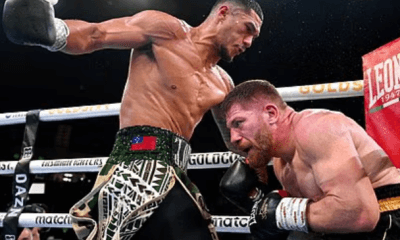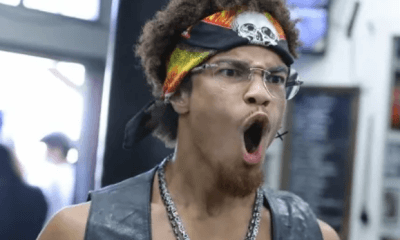Featured Articles
The Fighter Who Makes Bernard Hopkins Look Like A Kid
 Holding a press conference to announce an upcoming boxing match doesn’t mean, of course, that the fight will be held. One of the participants could be injured in training, forcing a cancellation, or he might object to the financial arrangements if there isn’t enough money to cover the promised purse.
Holding a press conference to announce an upcoming boxing match doesn’t mean, of course, that the fight will be held. One of the participants could be injured in training, forcing a cancellation, or he might object to the financial arrangements if there isn’t enough money to cover the promised purse.
There also could be a problem getting said bout officially sanctioned, which frequently is the case if the commission that determines such matters rules that a fighter is medically unfit to enter the ring, or if the promoter of the event somehow doesn’t pass the sniff test.
Given those potential factors, it is hardly a given that former featherweight Augie Pantellas, who will turn 70 on Feb. 16, actually will swap punches with a much younger opponent on June 7, 2014, the date he is tentatively scheduled to have his name entered in the Guinness World Book of Records as the oldest fighter ever to appear in sanctioned, non-exhibition bout. But Pantellas believes it will happen, and so does publicity-craving promoter Damon Feldman.
British cruiserweight Steve Ward is listed by Guinness as being the oldest professional boxer, having defeated Pete McJob in 2011, at 54, thus ending a 23-year retirement. But that designation is incorrect (the fight is not even listed by BoxRec); former WBC super lightweight champion Saoul Mamby was 60 when he lost a 10-round unanimous decision to Anthony Osbourne on March 8, 2008, in Georgetown, Cayman Islands. Regardless of whether Ward or Mamby has the more legitimate claim to the Guinness entry, however, Pantellas would easily shatter the record — if his proposed fight actually takes place.
“It’s a story because of my age,” said Pantellas, who compiled a 28-6 record, with 20 victories inside the distance, as a locally popular featherweight from 1967 to ’79, 32 of his 34 pro bouts being held in Philadelphia or one of its suburbs, Upper Darby, Pa. “But when people see me, they can tell I still have a youthful body. I’ve been blessed by God.
“I took my physical and my doctor said that everything’s good. I can still punch hard. I always could punch hard. Back when I was fighting, the punches came out a little quicker and sharper, but if I’m in shape, my punch will still be devastating. I still have that power.”
Feldman, a former super middleweight who compiled a 9-0 record with four knockouts before an injury ended his career in 1992, has stated that his first preference is to have Pantellas set the record in the Philadelphia area, where he still is a recognizable name (he was inducted in the Pennsylvania Boxing Hall of Fame in 2007). But if Feldman can’t get the go-ahead from the Pennsylvania State Athletic Commission, whose executive director, Greg Sirb, has something of a contentious history with him, he said he could take the fight to Los Angeles or Las Vegas.
“We’ll try to do it here (in Pennsylvania),” Feldman said. “We’ll give it the first shot. I’m not saying it can’t be done here. But wherever it’s held, there’s legitimacy. Augie is not some 70-year-old guy coming out of nowhere. He fought Sammy Goss and Bobby Chacon. The first time he fought Goss, at the Spectrum, he drew over 10,000.”
Sirb, who twice fought on “Celebrity Boxing” cards promoted by Feldman, might prove a tough sell when it comes to granting needed approval for the staging a Pantellas record-setter in Pennsylvania. Feldman became something of an outcast with the Pennsylvania commission some years ago when he got into a physical altercation with another promoter, P.J. Augustine, and wound up punching him out.
“I was a wild, young guy,” said Feldman, now 44. “I made mistakes. I admit it. But I don’t think I have a problem with Greg. In my book he’s the best commissioner there is.”
For his part, Sirb is reserving judgment on any application to issue a license to Pantellas, no matter how much Feldman appears to be buttering him up.
“Nothing has come across my desk about it,” he said. “It would all depend on what (Feldman) is trying to do. There will be no comment on my part about (a possible application) until I see it. But I will say this: Play by the rules, there’ll be no problem. Don’t play by the rules, you’ll have a problem. That applies to everybody.”
Neither Feldman nor Pantellas, who since 1979 has operated a lunch stand outside the Delaware County (Pa.) Courthouse in Media, is a stranger to controversy. Feldman’s “Celebrity Boxing” cards have included appearances by, among others, disgraced figure skater Tonya Harding, former baseball slugger and PEDs whistle-blower Jose Canseco, onetime Partridge Family kid Danny Bonaduce, L.A. police beating victim Rodney “Can’t We All Just Get Along?” King and Michael Lohan, fathered troubled actress Lindsay Lohan and apparently passed down some of his more outrageous genes to her.
Pantellas twice appeared in Feldman-promoted “Celebrity Boxing” exhibitions, and in 2007, upon his induction into the Pennsylvania Boxing Hall of Fame, he said he hoped to take on Muhammad Ali’s daughter, Laila Ali, in the sort of “Battle of the Sexes” that rocked the tennis world when 29-year-old Billie Jean King thumped 55-year-old Bobby Riggs on Sept. 20, 1973, in Houston’s Astrodome.
When Feldman told longtime Philly promoter J Russell Peltz of his plan to stage a Laila Ali-Pantellas bout, Peltz told him he didn’t think Sirb would ever agree to sanction it. “Well,” Feldman said, “do you think New Jersey might?”
In a Philadelphia Magazine profile a couple of years ago, writer Don Steinberg labeled Feldman “King of the D-List,” detailing at length Feldman’s many forays into the sublime and ridiculous, which have gained him frequent notices in local newspapers’ gossip columns and guest appearances on sports-talk radio station WIP.
“Damon has always been more about promoting himself than his events,” Peltz, a no-nonsense inductee into the International Boxing Hall of Fame, told Steinberg. “He’s more about the sizzle than the steak.”
But the idea of a Pantellas fight at 70, as Feldman noted, isn’t completely crazy. “The Broomall Bomber,” as Pantellas was known, looks 20 years younger than his actual age and he’s married to a woman 24 years his junior, which in and of itself would make him a hero to a lot of his fellow senior citizens. Pantellas again is training with Marty Feldman, Damon’s 80-year-old father, who posted a 20-3 record with 17 KOs during his own boxing career and who took a journeyman light heavyweight, “Prince” Charles Williams, all the way to the IBF title in 1987, a belt he successfully defended seven times.
Older athletes making cameo appearances strictly for PR purposes isn’t a particularly new concept, either. Minnie Minoso, now 87, was a .298 career hitter and winner of nine Gold Gloves as a major league outfielder for five teams from 1949 to ’63. Minoso played three games for the Chicago White Sox in 1976, at 50, and two more games for the White Sox in 1983. In 1993, at 67, he appeared with the independent St. Paul Saints of the Northern League and again in 2003, thus becoming the only professional baseball player to be listed in box scores in seven different decades.
To Pantellas’ way of thinking, what he is attempting to do is far less noteworthy than the idea of Bernard Hopkins, who turns 49 on Jan. 15, being the IBF light heavyweight titlist at an age when most fighters are long since retired.
“You think what I’m doing is unbelievable? Bernard Hopkins is unbelievable,” Pantellas said. “To be his age and still be a champion is something I can’t even imagine. Bernard Hopkins is the man.”
Well, B-Hop is not so bad for a relative kid of 48. Now, if he still holds is going strong in 2025 …
-

 Featured Articles3 weeks ago
Featured Articles3 weeks agoAvila Perspective, Chap. 330: Matchroom in New York plus the Latest on Canelo-Crawford
-

 Featured Articles2 weeks ago
Featured Articles2 weeks agoVito Mielnicki Jr Whitewashes Kamil Gardzielik Before the Home Folks in Newark
-

 Featured Articles4 weeks ago
Featured Articles4 weeks agoOpetaia and Nakatani Crush Overmatched Foes, Capping Off a Wild Boxing Weekend
-

 Featured Articles3 weeks ago
Featured Articles3 weeks agoCatching Up with Clay Moyle Who Talks About His Massive Collection of Boxing Books
-

 Featured Articles4 weeks ago
Featured Articles4 weeks agoFabio Wardley Comes from Behind to KO Justis Huni
-

 Featured Articles2 weeks ago
Featured Articles2 weeks agoMore Medals for Hawaii’s Patricio Family at the USA Boxing Summer Festival
-

 Featured Articles3 weeks ago
Featured Articles3 weeks agoThe Shafting of Blair “The Flair” Cobbs, a Familiar Thread in the Cruelest Sport
-

 Featured Articles3 weeks ago
Featured Articles3 weeks agoRichardson Hitchins Batters and Stops George Kambosos at Madison Square Garden















